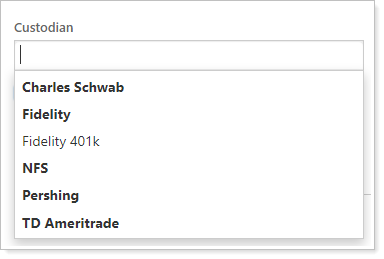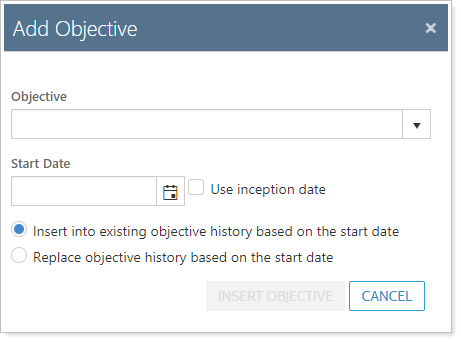 Back
Back
 Back Back |
Home > Advisor View > Accounts, Groups & Households > Accounts > Creating and Maintaining Accounts > Maintaining Accounts: The Account Settings Panel
|
Maintaining Accounts: The Account Settings Panel
|
|
The Account Settings panel allows you to configure the basic settings for the account, such as the account type, closed date, and inception dates.

This Help topic discusses only the fields on the Account Settings panel, available under the Settings menu when you edit an account. For more information on editing accounts, including how to navigate to this panel, visit Maintaining Accounts in Advisor View.
See below for descriptions of each of the settings on the page.
The number that identifies the account. This field is not editable in Advisor View and must be edited in the portfolio accounting system.

The type of account, such as IRA, Keogh, SEP-IRA, or Rollover. There are no restrictions on what you can type in this field.

If you also use Advisor Rebalancing, this is a field that is synchronized between the two products.
When you update this field for an individual account or accounts, you can sync those changes without running a full Advisor View sync. To learn more about syncing account changes for individual accounts, see Synchronize Account Data With Advisor Rebalancing.
The custodian of the account.

If you plan to participate in an integration such as Schwab Intelligent Integration, be sure to select the correct custodian here. All custodians that are linked to a custodial integration appear in a bold font. This way, you won't need to know whether you should choose Charles Schwab or Schwab – just choose the custodian that's in a bold font.
If you also use Advisor Rebalancing, this is a field that is synchronized between the two products.
When you update this field for an individual account or accounts, you can sync those changes without running a full Advisor View sync. To learn more about syncing account changes for individual accounts, see Synchronize Account Data With Advisor Rebalancing.
This is the date that will be shown in the Closed Date column for saved searches and it also determines what you see on the Accounts page views. For those views, you can choose whether or not to show closed accounts, or you can show the closed accounts only when they are members of a group.

For dynamic reports, you will automatically see account data for accounts that were active within any part of the reporting period, even if the account closed before the end of the reporting period. For PDF reports, you will not automatically see data for any accounts that closed within the reporting period. For more information on closed accounts, view Show Returns for Closed Accounts.
You can enter current or previous dates. For partial ownership accounts, the closed date is inherited from the parent account if you enter a date that is later than the parent account's closed date, or if you leave this field blank.

When you enter a closed date for an account, a confirmation request warns you that if you continue, the account's value—and the value of all manual security positions in the account—will be set to $0 as of the closed date. You'll also see a confirmation when you reopen an account, and you’ll see warnings in the upload status when closed dates are changed through a data upload.
To see accounts that are closed but still receiving custodian information, you can review the Closed and Linked Accounts daily report available on the FTP site.
The performance inception date tells Advisor View when to begin calculating performance for an account. Before you can calculate intervals to run performance reports, you must give each account a performance inception date.

When you select the Auto generate date check box, Advisor View will set the performance inception date to the day before the first transaction. If you'd prefer a different date, such as the day of the first transactions (or any day after the first transaction), you can type a different date in the Performance Inception Date box.
Advisor Kelly receipts in securities that are going to be sold as part of the initial management rebalance. Because Kelly does not want to track performance of those securities, Kelly sets the Performance Inception Date to the day the rebalance is completed.
Designates whether the account is taxable or non-taxable.

If you also use Advisor Rebalancing, this is a field that is synchronized between the two products.
When you update this field for an individual account or accounts, you can sync those changes without running a full Advisor View sync. To learn more about syncing account changes for individual accounts, see Synchronize Account Data With Advisor Rebalancing.
Designates whether the account is discretionary or non-discretionary.

If you also use Advisor Rebalancing, this is a field that is synchronized between the two products.
When you update this field for an individual account or accounts, you can sync those changes without running a full Advisor View sync. To learn more about syncing account changes for individual accounts, see Synchronize Account Data With Advisor Rebalancing.
Designates whether or not you want the account to be included in the nightly sync with Advisor Rebalancing. If you don't plan to monitor this account for rebalancing triggers, you'll want to clear this check box.

If you select this check box, the Account Type, Taxable, Custodian, and Discretionary fields will also be integrated with Advisor Rebalancing.
If you also use Advisor Rebalancing, this is a field that is synchronized between the two products.
When you update this field for an individual account or accounts, you can sync those changes without running a full Advisor View sync. To learn more about syncing account changes for individual accounts, see Synchronize Account Data With Advisor Rebalancing.
The reconciliation status shows whether an account is currently reconciled, force published, unreconciled, or missing. This field is a read-only field that is updated by your portfolio accounting system.

Reconciliation occurs as appropriate depending on the account, whether daily or another frequency. The reconciliation status in Advisor View matches both your portfolio accounting system and what your Tamarac Service Team sees.
Ownership accounts are not reconciled.
Possible statuses:
| Status | Meaning |
|---|---|
| Closed and Linked | Account is closed but still receiving data from the custodian. |
| Linked | Account is receiving data from the custodian. |
| Manual | Reconciliation frequency in your portfolio accounting system is being updated manually. |
| Missing | Custodian data is out of date. |
| Reconciled | Account data is up to date with the portfolio accounting system. |
| Unreconciled | Account data is out of date with the portfolio accounting system. |
The last reconciliation date shows the last date a position reconciliation was performed on the account. This field is a read-only field that is updated by your portfolio accounting system.

Ownership accounts are not reconciled.
Select this check box if you want the amortization calculation to be enabled. Enabling the amortization calculation will calculate the amortization directly within Advisor View based on the security and transaction details, as well as the amortization method(s) that have been applied to the security types.

This setting lets you add an investment objective for this account, such as growth or aggressive. All objectives you've previously used will appear in the list. If you want to add a new objective type, you can type it in the list.

When entering the objective, you have the option to add a start date. You can choose any start date you want. If you prefer to use the inception date, select the Use inception date check box and Advisor View will set the start date to the inception date for you.
If you're changing objectives, Advisor View can keep track of objective changes for the account. When entering a start date for the objective, choose one of the following:
Insert into existing objective history based on the start date. Select this option to insert the selected objective into the account’s comparison history based on the start date. If you set the objective to today's date, the change will be reflected on the next day.
Replace objective history based on the start date. Select this option to replace all objectives associated with the selected account from the start date.
Advisor Kelly has an account with the following objective history:

Kelly wants realizes that there was a period starting on 1/1/2009 where the account actually had a Moderately Aggressive objective before it changed to Aggressive on 1/1/2011.
Selecting the Insert into existing objective history based on the start date check box inserts the Moderately Aggressive objective into the objective history starting at the start date entered for the Moderately Aggressive objective and ending at the start date for the Aggressive objective.

Selecting the Replace objective history based on the start date check box inserts Moderately Aggressive into the objective starting at the start date entered and extends it to the present, overwriting the Aggressive objective.

When finished, click Add Objective.
Choose the advisors for the account. All advisors you've previously used will appear in the list. If you want to add a new advisor type, you can type it in the list and then click Add. You can designate the primary advisor by selecting the Primary Advisor check box. The Primary Advisor check box is synced to Advisor CRM.

In a future release, we'll be removing this field because the Service Teams feature will take its place. To avoid interruptions in your daily workflows, we're leaving this feature in place, but to avoid any potential disruptions, you'll need to transition to the new Service Team structure before this field is removed.